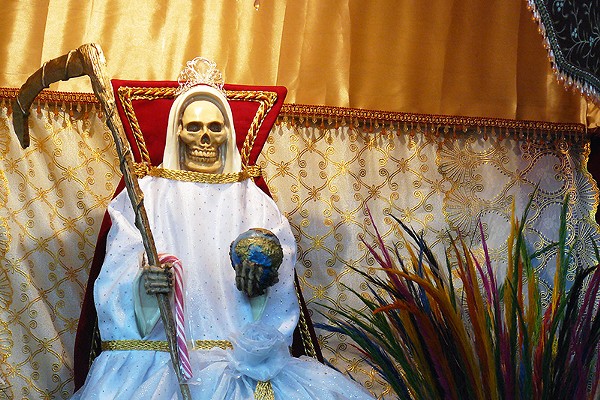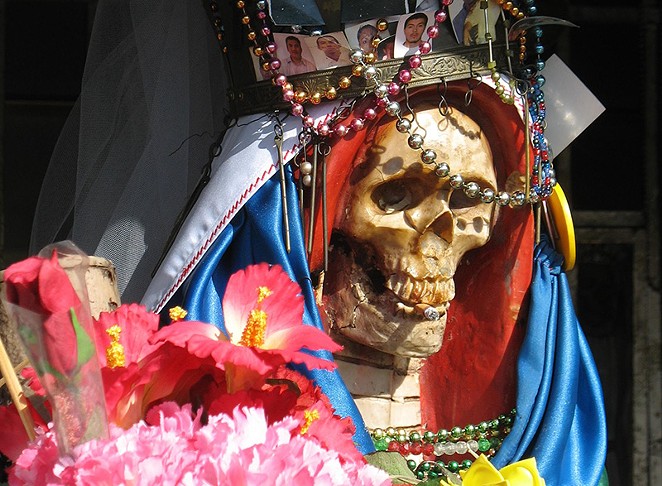Casa Guajardo is cluttered but tidy. Inside the shop, a botánica on the South Side along South Flores, veladoras are stacked from the floor to the white tile ceiling along one wall, with rows of garlic drooping between the different sections. Incense packets, each with a specific purpose, sit in old bins on the opposite side of the store.
A handful of statues are scattered across Casa Guajardo where people have made offerings to the saint known as Santa Muerte. One, cloaked in a thick, billowy black slab of concrete, stands about 4 feet high. Several more are lined up behind a glass case like toy soldiers. Another is about the size of a nutcracker and sits on a throne, jeweled scythe in hand.
Pennies and dimes are stacked and scattered around each of them, and rolled-up dollar bills are taped to their cloaks. Folded up notes sit at their feet, the paper not quite transparent enough to read the scrawled message inside without opening them up.
"Those are all the things she likes," Annette Guajardo, whose family owns the shop, said of the offerings. "People have just started praying to her like crazy. Some people, they're scared of her."
The divisive religious icon, which draws from Catholicism and more mystical faith traditions but is officially condemned by the church, is associated with protection. She attracts the downtrodden and dangerously ambitious alike, and her dry and bony hand has reached up from Mexico and grasped South Texas. Millions of people pray to her, and the devotion surrounding Santa Muerte is now the fastest-growing religious movement in the Americas – San Antonio included.
It's no surprise that Santa Muerte has taken hold in San Antonio, given the city's deep Mexican heritage and the saint's appeal to the working class. Her followers aren't looking for redemption or a moral code; they turn to Santa Muerte because they're desperate. They need something, and they believe she can give it to them – for a price.
Maígorzata Oleszkiewicz-Peralba, a professor at the University of Texas at San Antonio who's studied Santa Muerte, attributes the saint's surge in popularity to increased desperation by people looking for answers to the problems in their lives.
"Nothing works for them – no governments, no churches effectively protect them. It is a saint of last resort. Nothing else works, so who can be more powerful than death?" said Oleszkiewicz-Peralba.
Devotion to Santa Muerte isn't a religion in and of itself. It's a transactional relationship – strictly business. In exchange for something – a raise at work, a new truck, a cured ailment – devotees promise to do something in return for Santa Muerte. The offering could be as simple as a candle or a piece of fruit at her feet. Others give cigarettes or money, or promise to get a tattoo of her or wear a piece of jewelry in her image.
"The devotions are geared toward survival on a daily basis, not for salvation after death," Oleszkiewicz-Peralba said. "She's very jealous. If you promise something and you don't deliver, then she will punish you."
The punishment could take various forms, but devotees take the repercussions seriously.
"She has a reputation for retribution. Sometimes in Mexico you hear if you don't fulfill your end of the bargain, she might take your entire family as an act of retribution," said Andrew Chesnut, a professor of Latin American religion at Virginia Commonwealth University who wrote one of the first books in English on Santa Muerte. "She's death. She can visit death upon whom she chooses."
Death Be Not Proud
Santa Muerte's rise began in Mexico in the mid-2000s. She has steadily crept past the border since then, and interaction between devotees on social media has extended her influence.
Santa Muerte devotees in San Antonio cluster on the city's South and West Sides, where a constellation of botánicas stock statues, spell books, candles and other necessary items. She's so popular that she's supplanted Our Lady of Guadalupe as the female religious icon of choice in some places.
In Mexico, there are public temples where devotees can come together and worship. They persist even after the Mexican army destroyed dozens of public shrines in March 2009, portrayed as an effort to quell cartel activity by demolishing signs of their chosen patroness.
Devotion to Santa Muerte is an exceptionally malleable following. There is no governing institution or central code. People adapt her to their own needs, and she's become a patroness for a cadre of diverse groups: the LGBT community, the poor, people in dangerous professions, healers, bartenders and others count her as a protector. To ask for help, a small statue, a book of prayers or spells and a YouTube tutorial is more than enough to get started.
"There's a fair amount of people on both sides of the border who are not interested in organized religion, and this is disorganized religion," Chesnut said.
But Santa Muerte also has a more malevolent reputation. She has an intense following among the drug cartels, whose members cling tightly to the belief that she'll protect them from death or arrest.
Over the past decade, Santa Muerte iconography has become inextricably linked with violence. Wearing Santa Muerte jewelry has been used as probable cause to make arrests along the border.
But most of her followers distance themselves from Santa Muerte's associations with the cartels. They say she unfairly gets a bad rap.
"A lot [of devotees] will protest vociferously, saying 'It's not fair that the media paints us as narcos and criminals,'" Chesnut said.
John, a Santa Muerte devotee from San Antonio, wouldn't allow us to use his real name in this story because he feared how his family would respond if they knew he prayed to her. John is in his mid-20s. He dresses in red from his T-shirt to his sneakers. It's the same color as the Santa Muerte sculpture he's prayed to for just over a year.
John says he mostly prays for protection from the police, and he's convinced it works. But he asks for other things too: a new car, for one. He's also asked Santa Muerte to help his sister regain full custody of her kids from Child Protective Services. If Santa Muerte delivers, John plans to repay her "with a tribute of his body."
"I'm going to devote part of my body to her with a tattoo," he said, marking the spot on his upper thigh where he plans to get the tattoo, and gesturing all the way down to his foot. John is already heavily tattooed, with the stylized names of loved ones peeking above the collar of his T-shirt.
Although John said he wasn't involved with drugs, he disagrees with other followers who protest the cartel connection.
"We're asking for the same thing," he said. "We both want protection."
The business of muerte
Devotion in San Antonio is more private compared to Mexico. There are no public temples, and people tend to restrict offerings and contemplation to their own homes or at botánicas. People construct altars around the saint to conduct prayers and offerings. They range from simple miniature stages to ornate structures.
At Casa Guajardo, Santa Muerte items have become one of the shop's top sellers. Annette Guajardo said that Santa Muerte products now make up about half of the shop's total sales.
She recently sold several giant statues to another shop in town for over $600 apiece. So much money stacks up around the statues in the shop that it eventually topples to the floor. When that happens, they use it to buy roses for devotees to offer to her.
Guajardo said that people come to pay their respects in a steady stream. They do so, she says, because they get results.
"I respect her, but I don't pray to her. People pray for their job, for money, for health," Guajardo said. "That's why she's become so popular – they get what they ask for."




















